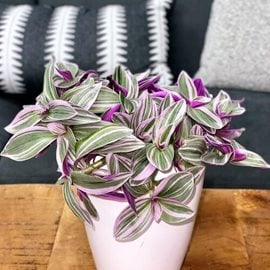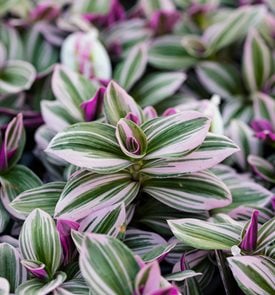HOW TO GROW TRADESCANTIA PLANTS
Grow this versatile perennial as a houseplant or outdoors in the landscape
New Vogue™ Feeling Flirty™ tradescantia. Photo by: Proven Winners
Tradescantia is a diverse plant genus encompassing tropical species that are suitable as indoor houseplants, as well as hardy species that can be grown outdoors. Tropical varieties are typically grown for the attractive foliage that comes in an array of colors and patterns, while hardy types are grown for their charming three-petaled flowers that bloom for weeks during spring and summer.
This forgiving easy-to-grow plant is suitable for beginning gardeners and has a wide range of uses, whether augmenting interior spaces or when planted in the landscape. Add spiderwort plants to shade gardens, woodland borders, containers, or hanging baskets. Here’s how to grow and use this versatile plant in your home decor or landscape.
On this page: Basics | Growing Tips | Care and Maintenance | Tradescantia Varieties | Toubleshooting | Display Ideas
On this page:
- BASICS
- TRADESCANTIA GROWING TIPS
- TRADESCANTIA CARE AND MAINTENANCE
- TRADESCANTIA VARIETIES
- TROUBLESHOOTING
- DISPLAY IDEAS
BASICS
Botanical name:
Tradescantia spp.
Common names:
Spiderwort, purple spiderwort, Virginia spiderwort, common spiderwort, purple heart, wandering dude, trinity flower, inch plant, widow’s tears, oyster plant.
Origin:
Native to North America, Central America, and South America
Zones:
Most hardy types can be grown outdoors in USDA Zones 4-9. Tropical or semi-tropical species are hardy in Zones 9-12, depending on the variety.
Care level:
Easy
Light requirements:
Full sun to shade, depending on the variety. Houseplants prefer bright indirect light.
Growth rate:
Medium to fast, depending on the variety
Foliage:
Hardy varieties of spiderwort produce strappy grass-like leaves that grow in clumps, in colors of green, blue-green or gold. Plants may die back during the heat of summer, returning from late summer to fall.
Tropical varieties, which are grown primarily for the foliage, produce pointed or lance-shaped leaves, with solid or variegated patterns in shades of green, white, silver, purple, pink or cream.
Flowers:
Three-petaled flowers 1/2 to 2 inches wide come in shades of white, purple, lavender, blue, or pink. The flowers on tropical species are insignificant compared to hardy outdoor species. Individual flowers last for a single day. Bloom time varies depending on the variety and growing conditions.
Habit and size:
Upright, spreading or trailing habit; 3 to 36 inches tall, 9 to 24 inches wide
Is tradescantia poisonous?
Tradescantia is mildly to moderately toxic to pets and children. Contact with the sap can cause itching and skin irritation. Ingestion may cause stomach upset or other digestive issues. Contact your doctor, veterinarian or local poison control if necessary.
Tradescantia lookalikes:
- Creeping inch plant (Callisia repens) has similar leaves to tropical varieties of Tradescantia, but the leaves tend to be smaller and come in different colors or patterns.
- Dracaena (Dracaena spp.) can have strappy variegated foliage similar to some types of Tradescantia.
TRADESCANTIA GROWING TIPS

Tradescantia pallida. Photo by: Toyakisphoto / Shutterstock
Where to grow:
Indoors, place near a window that receives bright indirect light. Outdoors, place in a spot that receives full sun (with protection from afternoon sun in the hottest regions) to shade, depending on the variety. Indoor houseplants can be placed outside in a bright shady area during warmer months.
Temperature:
Indoor houseplants prefers temperatures between 55-80 degrees, and no colder than 50 degrees.
Humidity:
They also prefer higher humidity. During winter when indoor humidity levels are low, place plants on a tray filled with pebbles and water or use a room humidifier to increase humidity.
Soil type:
Garden plants prefer rich, well-draining soil with an acidic pH of 5.0-6.5. They are adaptable to average garden soil as long as they don’t dry out. For indoor houseplants, use a high quality all-purpose potting soil.
Pot requirements:
Choose a pot that is slightly wider and deeper than the root ball. Make sure containers have good drainage to prevent root rot.
Propagation:
Tradescantia is easy to propagate from stem cuttings, offsets, division, or seed. Place offsets or cuttings in water to root, or plant directly into soil. Divide hardy perennials every few years in spring or fall. Start seed indoors 8 weeks before transplanting outside.
2023 Houseplant of the Year:
New Vogue™ Feeling Flirty™ Tradescantia
New breeding, more compact, and more colorful!
A unique version with pink and green striped foliage that looks as if it was painted on. This trailing plant is perfect for hanging baskets or as a spiller element in mixed containers. Like other spiderworts, Feeling Flirty™ can be grown indoors or out; 2 to 4 inches tall, trails up to 36 inches.
See the entire leafjoy® houseplant collection from Proven Winners.
TRADESCANTIA CARE AND MAINTENANCE
Watering:
Tradescantias prefer moist soil. Provide good drainage and avoid overwatering to prevent root rot. Underwatering can cause plant stress. Water plants when the soil surface is dry 1-2 inches deep.
Fertilizing:
Fertilize houseplants monthly during the growing season with a balanced liquid fertilizer. For outdoor plants, apply a slow-release all purpose fertilizer in early spring and mulch with a thin layer of compost.
Pruning:
Trim back vining types if they become leggy to encourage a fuller habit. Hardy varieties may become untidy after flowering. Shear back by a third to reinvigorate and encourage late season rebloom.
Repotting:
If roots are circling the bottom of the pot or growing out of the drainage holes, it’s time to repot. Do this in spring when plants emerge from semi-dormancy. Remove plant from the pot, taking care not to break the fragile stems, and gently tease out roots. Place in a new container that is 1 to 2 inches larger than the previous pot and use fresh soil. Water thoroughly and place in bright indirect light.
Pests:
Indoor houseplant pests may include aphids, spider mites, thrips, scale, and fungus gnats. Rinse plants with water, dab affected areas with 70% rubbing alcohol, or use an insecticidal soap for severe infestations. Garden pests include aphids and slugs.
TRADESCANTIA VARIETIES
TROUBLESHOOTING
Indoor Houseplants:
- Faded leaf color can indicate too much or too little light. Move plants to a better light source.
- Leaf scorch can indicate too much light. Move plants out of direct sunlight.
- Wilted or yellowing leaves, stunted growth, or mushy stems can be symptoms of overwatering, which can result in root rot and fungal diseases. Make sure pots have adequate drainage and reduce watering. Plants may need repotting in fresh soil.
- Brown leaf tips can be a response to low humidity. Place houseplants on a saucer filled with pebbles and water, or use a room humidifier to increase air moisture.
- Brown leaf tips can be a sign of low air moisture. Use a room humidifier, mist plants twice a week or place pot on a saucer filled with water and pebbles. Don’t allow pot bottom to stand in water.
- Leaf curl can be an indication of several factors. Leaves that curl inward are a sign of underwatering. Leaves that curl outward can indicate overwatering or not enough light. Adjust growing conditions as needed.
- Brown mushy roots are a sign of root rot from overwatering. Make sure plants have good drainage and don’t overwater. Cut out damaged roots and repot in fresh soil. In extreme cases, plants may need to be discarded.
Outdoor Plants:
- Yellow or brown lesions on foliage can indicate rust, which is due to too much shade or poor air circulation. Move plants to a sunnier spot, thin plants and reduce watering.
- Tan spots on leaves can be a sign of tan leaf spot, which is a virus affecting grassy plants. Remove affected leaves and discard in the garbage rather than compost pile to prevent spread of disease.
- Mottled pattern of green and yellow on leaves may indicate mosaic virus. Remove affected leaves and discard in the garbage.
DISPLAY IDEAS

Photo by: jamaludinyusuppp / Shutterstock
- Use a spreading type as a groundcover around shrubs or to quickly fill in bare spots.
- Plant a trailing variety in a hanging basket and display on a shady patio, deck, or porch during warmer months.
- Display a tropical vining type in a decorative hanging pot to dress up a kitchen or living room window.
- Adorn a book shelf, dining or end table with an upright or trailing tropical variety.
- Group several tradescantia together with foliage in different colors, sizes and shapes on an indoor table or shelf for a tropical effect to lift your spirits during winter months.
- Add a living accent to a bathroom where your plant will benefit from the extra humidity.
- Mass a hardy variety near a pond, stream, bog, or other water feature for fine grassy texture and weeks of flower color.
- Place a small to medium-sized specimen in a colorful pot and display on your office desk to liven up your work environment.
- Mix a hardy variety with other moisture-loving plants such as astilbe, hosta, bee balm, and cardinal flower in a woodland border.
RELATED:
21 Best Indoor Plants
A Guide to Growing Peace Lily
A Guide to Growing Pothos










